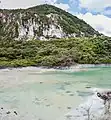| Maunga Kākaramea (Rainbow Mountain) | |
|---|---|
 | |
| Highest point | |
| Elevation | 743 m (2,438 ft)[1] |
| Coordinates | 38°19′09″S 176°22′42″E / 38.31917°S 176.37833°E[2] |
| Geography | |
 Maunga Kākaramea (Rainbow Mountain) | |
| Geology | |
| Mountain type | Stratovolcano |
| Last eruption | Hydrothermal about 1315 CE, as dacite about 180,000 years ago[3] |
| Climbing | |
| Easiest route | Mt Kakaramea (Rainbow Mountain) Summit Track |
| Access | State Highway 5 |
Maunga Kākaramea (also known officially as Rainbow Mountain)[1] is a 743 metres (2,438 ft)[4] high dacite volcano located between Rotorua and Taupō in the North Island Volcanic Plateau. It has multiple steaming features and a picturesque crater lake reached by a short walk from the nearest road and has a nearby geothermal area.
Geography
Maunga Kākaramea (meaning mountain of coloured earth, sometime called Maungakakaramea and also known in colloquial English as Mount Kakaramea - but do not confuse with Kakaramea another mountain) is located at the western borders of the Okataina Volcanic Centre. To the north west is the still active Waimangu Volcanic Rift Valley and closer to the south west the Maungakaramea hot springs. To the west across the Hakereteke stream (European settlement name Kerosene Creek) valley is the slightly higher peak of Maungaongaonga at 825 metres (2,707 ft).[4]
Geology
Much of the ground has been altered by steam action, which is most marked on the southern slopes of the mountain, extending almost to the summit. The steam has created fumarole clays of decomposed rhyolite.[5] The six craters on the mountain are likely of hydrothermal origin. [6] There have been quite large hydrothermal eruptions from areas of the mountain and nearby. This erupted material overlie the 232 CE Hatepe eruption pumice resulting in estimated eruption ages of about 1300 CE.[7] Sulphur deposits and natural petroleum seeps occur in the area.[6][2] The bare northern slopes are adjacent to the Ngapouri-Rotomahana Fault which is a splay of the Paeroa Fault at the eastern margin of the Taupō Rift of the Taupō Volcanic Zone. These slope's steam activity was much more marked following the last Tarawera eruption than at present. The hot water spring activity is all to the south of the fault line.[6] Accordingly just to the north we have an area that is displacing at a rate of 7.2 ± 0.4 mm/yr explaining the areas complex geology.[8][9]
Tourism
Its emerald coloured crater lake is a short but steep walk for the fit from a car park off State Highway 5 and contrasts with ochre coloured cliffs. The flora is somewhat stunted both because of the continued geothermal activity but also as it is a regrowth area affected by the 1886 eruption of Mount Tarawera.
 View of Maunga Kākaramea from Rainbow Mountain Scenic Reserve
View of Maunga Kākaramea from Rainbow Mountain Scenic Reserve Coloured cliffs of Maunga Kākaramea
Coloured cliffs of Maunga Kākaramea Close up of coloured cliffs of Maunga Kākaramea
Close up of coloured cliffs of Maunga Kākaramea View of lake in Rainbow Mountain Scenic Reserve
View of lake in Rainbow Mountain Scenic Reserve Crater lake Maunga Kākaramea
Crater lake Maunga Kākaramea
See also
References
- 1 2 "LINZ: Maunga Kākaramea (or Rainbow Mountain)". 2023.
- 1 2 Rainbow Mountain Thermal Area, Waiotapu (Wai-O-Tapu), Rotorua District, Bay of Plenty Region, New Zealand
- ↑ Berryman, Kelvin; Villamor, Pilar; Nairn, Ian.A.; Begg, John; Alloway, Brent V.; Rowland, Julie; Lee, Julie; Capote, Ramon (2022-07-01). "Volcano-tectonic interactions at the southern margin of the Okataina Volcanic Centre, Taupō Volcanic Zone, New Zealand". Journal of Volcanology and Geothermal Research. 427: 107552. Bibcode:2022JVGR..42707552B. doi:10.1016/j.jvolgeores.2022.107552. S2CID 248111450.
- 1 2 "NZTopoMap:Maunga Kākaramea".
- ↑ Hutton, F.W. (1887). "The Eruption of Mount Tarawera". Quarterly Journal of the Geological Society. 43 (1–4): 178–189. doi:10.1144/GSL.JGS.1887.043.01-04.16. S2CID 128945495.
- 1 2 3 Lloyd, E.F. (1958). "The hot springs and hydrothermal eruptions of Waiotapu: Maungaongaonga Fumarolic Area". New Zealand Journal of Geology and Geophysics. 2: 141–176. doi:10.1080/00288306.1959.10431319.
- ↑ Cross, D. (1963). "Soils and geology of some hydrothermal eruptions in the Waiotapu district". New Zealand Journal of Geology and Geophysics. 6 (1): 70–87. Bibcode:1963NZJGG...6...70C. doi:10.1080/00288306.1963.10420090.
- ↑ Villamor, Pilar; Berryman, Kelvin (2001). "A late Quaternary extension rate in the Taupo Volcanic Zone, New Zealand, derived from fault slip data". New Zealand Journal of Geology and Geophysics. 44 (2): 243–269. Bibcode:2001NZJGG..44..243V. doi:10.1080/00288306.2001.9514937. S2CID 129679959.
- ↑ Berryman, Kelvin; Villamor, Pilar; Nairn, I.A.; Dissen, Russ; Begg, John; Lee, Julie (2008-06-01). "Late Pleistocene surface rupture history of the Paeroa Fault, Taupo Rift, New Zealand". New Zealand Journal of Geology and Geophysics. 51 (2): 135–158. Bibcode:2008NZJGG..51..135B. doi:10.1080/00288300809509855. S2CID 128400528.
